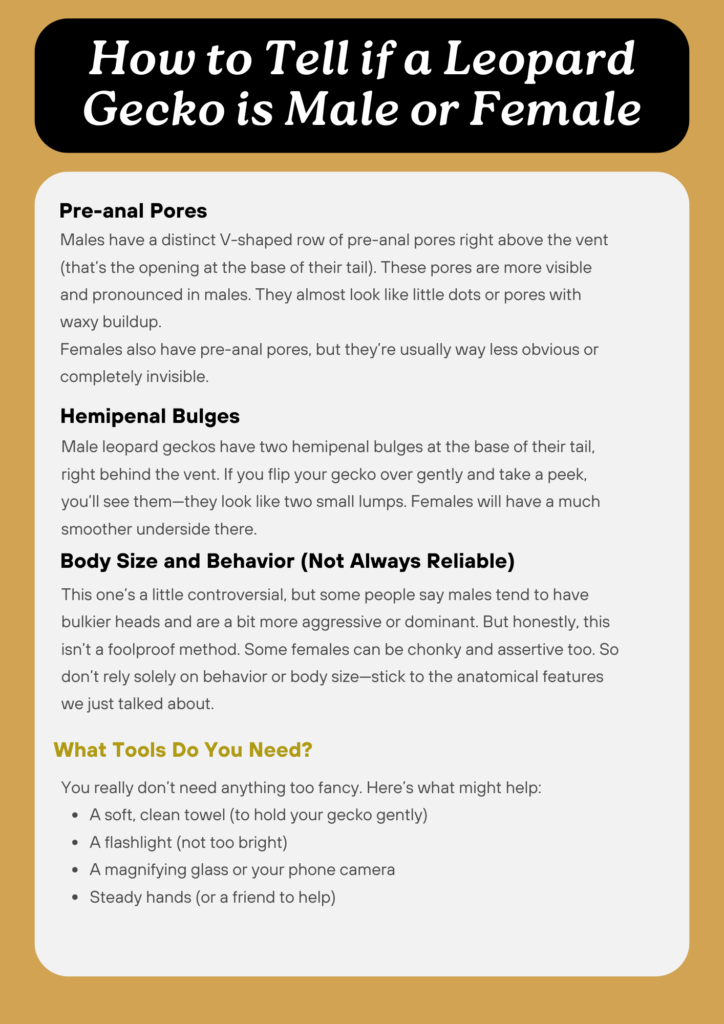Okay, so you’ve got yourself a cute little leopard gecko, or maybe a few of them, and you’re probably wondering—is my leopard gecko is male or female? It’s a pretty common question among new gecko owners (or even seasoned ones who just never checked!). Whether you’re looking to avoid accidental breeding, name your gecko properly, or just satisfy your curiosity, learning how to tell if a leopard gecko is male or female is a good skill to have. The thing is, it’s not always super obvious at first glance. They’re not like dogs or cats where you can usually tell pretty quickly. But don’t worry—I’ll walk you through it in a way that’s simple and actually kinda fun.
Why It Even Matters
Before we jump into the nitty-gritty of gecko anatomy (yes, we’re going there!), let’s quickly talk about why you’d even want to know their sex. For starters, if you’ve got more than one gecko, it helps to know if they’re the same gender. Males can be territorial and may fight if kept together. And of course, if you’ve got a male and a female, don’t be surprised if you end up with eggs on your hands one day.
Also, knowing their gender can help with health monitoring. For example, females can sometimes become egg-bound (a condition where they can’t lay eggs), which is something males obviously won’t deal with.

What Age Should You Sex a Leopard Gecko?
Alright, so here’s where a lot of people mess up (been there, done that). Trying to sex a gecko too early is not only difficult, but you can also totally misjudge it. Baby geckos don’t really show clear signs until they’re around 6 months old, give or take. Some people say you can start seeing differences at 4-5 months, but honestly, it’s kinda like trying to guess a baby’s future career based on their pacifier choice—just wait a bit.
So, patience is key! If your gecko is still young, give it time before trying to figure things out.
Physical Differences Between Male and Female Leopard Geckos
Now for the good stuff. There are a few tell-tale signs that can help you identify your gecko’s gender. And no, it doesn’t involve putting a little gecko in a dress or tux.
1. Pre-anal Pores
This is probably the most reliable way to determine the sex of a leopard gecko. Males have a distinct V-shaped row of pre-anal pores right above the vent (that’s the opening at the base of their tail). These pores are more visible and pronounced in males. They almost look like little dots or pores with waxy buildup.
Females also have pre-anal pores, but they’re usually way less obvious or completely invisible.
Tip: Use a magnifying glass or your phone’s camera with zoom to check this if your eyes aren’t hawk-level sharp.
2. Hemipenal Bulges
Ah yes, the infamous bulges. Male leopard geckos have two hemipenal bulges at the base of their tail, right behind the vent. If you flip your gecko over gently and take a peek, you’ll see them—they look like two small lumps. Females will have a much smoother underside there.
This is one of the easiest and most visual clues once your gecko is old enough.
3. Body Size and Behavior (Not Always Reliable)
Okay, so this one’s a little controversial, but some people say males tend to have bulkier heads and are a bit more aggressive or dominant. But honestly, this isn’t a foolproof method. Some females can be chonky and assertive too. So don’t rely solely on behavior or body size—stick to the anatomical features we just talked about.
What Tools Do You Need?
You really don’t need anything too fancy. Here’s what might help:
- A soft, clean towel (to hold your gecko gently)
- A flashlight (not too bright)
- A magnifying glass or your phone camera
- Steady hands (or a friend to help)
Just remember: don’t stress your gecko out too much. If they start freaking out, give it a break and try again later.
Common Mistakes When Sexing a Gecko
Yep, here come the “oops” moments that almost every reptile parent has done at some point.
- Checking too early – We already talked about this, but seriously, this is probably the #1 mistake.
- Being too rough – Geckos are delicate creatures. Be gentle when handling and flipping them over.
- Not checking under good light – If you’re trying to check in a dim room, you’re gonna have a bad time.
- Trusting behavior over physical traits – Just because your gecko is chill doesn’t mean it’s a female.
- Assuming from size alone – Males can be bigger, but that’s not a guarantee.
Can a Vet Help?
Absolutely. If you’re really unsure and don’t want to risk it, a reptile vet can definitely help you determine the gender. It’s a quick thing for them, and sometimes they’ll even show you how to check so you can do it next time.
Final Thoughts
So there you have it! Now you (hopefully) know how to tell if a leopard gecko is male or female, or at least feel more confident giving it a shot. Just remember to be patient, gentle, and observant. Once your gecko is about 6 months old, those little clues—like hemipenal bulges and pre-anal pores—should start to reveal themselves.
And hey, even if you still can’t tell 100%, don’t stress. Leopard geckos don’t really mind what you call them… but if you’re planning on breeding, yeah, you’ll definitely want to know!

